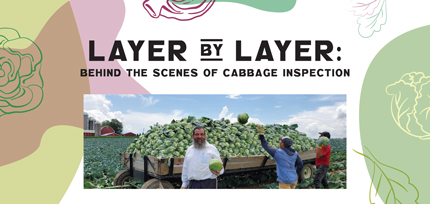Recently OK Kosher posted pictures of me inspecting a few cabbage fields on their Instagram account. I would like to take this opportunity to explain what I was doing there.
As a field representative my role is to verify that OK policies and procedures are being followed at the facilities I visit. My job in the field is to follow the standards that the OK Kosher rabbonim provide in order to assure that the food is “kosher without compromise”. This is why I feel that it is important for you, the consumer, to be privy to a behind the scenes look at cabbage inspections.
INTRODUCTION
Fruit and vegetables are inherently kosher, with three exceptions:
1) Israeli produce requires tithing of terumos and ma’asros before it may be used.
2) Israeli produce cannot be harvested or exported during a shmitta year.
3) We are prohibited from eating the new fruit of a tree (orlah) for the first three or four years.
Recently, we have been presented with a new problem: insects. While insects are not part of the fruit and vegetables, they often adhere to them,
and are difficult to find and remove. This issue has been discussed at length in the Shulchan Oruch (Code of Jewish Law), but has come to the forefront
due to changes in pesticide use over the past few decades. Commercial pesticides were developed in the late 19th century and by the mid-20th century the use of strong pesticides, like DDT, was widespread. During those years there was less risk of infestation and the issue was not a common one.
After nearly a century of pesticide use, scientists discovered that the pesticide runoff contaminated the local water supply and public opinion turned to minimizing the use of pesticides as much as possible. Furthermore, some consumers started insisting on buying only organic, pesticide-free produce.
Currently, USDA regulations allow produce with minimal amounts of insects to be classified as fit for human consumption. While this may or
may not be healthy for humans, it is surely not acceptable from a kashrus standpoint.
HALACHIC GUIDELINES
The generally accepted Halachic guidelines differentiate between:
a) “Miyut She-Ainoi Motzoi” when the (overwhelming) majority of this species of produce is insect free. It is rare (less than 10%) to find insects
on this fruit or vegetable.
b) “Miyut Hamotzoi” when a majority (over 50%) of this type of produce does not have infestation, yet it is somewhat common to find insects (in over 10% of this produce).
c) “Rov” when insects may be found in a majority of this type of fruit or vegetable.
This article is not the place to discuss all of the Halachic ramifications; there has been much written on this subject and this is merely a brief review.
Another important note is that the prohibition of eating insects is mentioned in the Torah numerous times. Depending on the type of insect,
there can possibly be six Torah prohibitions for eating them. In addition, the halachic principal of bittul cannot be applied to insects.1 Even the
smallest insect is a “berya” a complete creature which cannot be nullified.
WHAT SIZE INSECT?
Lo nitna Torah l’malachei hashareis – The Torah was given to human beings, not to angels. Consequently, when the Torah prohibits eating
insects, it means the insects that we can see with a naked eye. So, how do we apply this practically?
The Halacha refers to people who have reasonably healthy eyesight. Today, about 75% of people use corrective lenses, and even then, many do not
achieve 20/20 vision.
Part of the difficulty of spotting insects is because they blend in to their host. Hashem created insects with colors that match their habitats, which serves as protection from predators. Consequently, it may take some
training in order to be able to spot insects on produce. Trained mashgichim are able to spot insects much more readily than the average person checking produce at home. In addition, mashgichim are aided by light boxes and magnifying equipment, which helps simplify inspections.
For those who cannot see well, either with or without glasses, there are specialized procedures and magnifying devices that make washing
produce and inspection for insects easier. In our next installment, I will endeavor to describe the actual procedures for the cabbage fields and the
type of insects that can be found there.
1 See Kosher Spirit Pesach 5778 for a more in-depth discussion.


 EN
EN  ZH
ZH  KR
KR  BR
BR  ES
ES  IN
IN  IL
IL 




